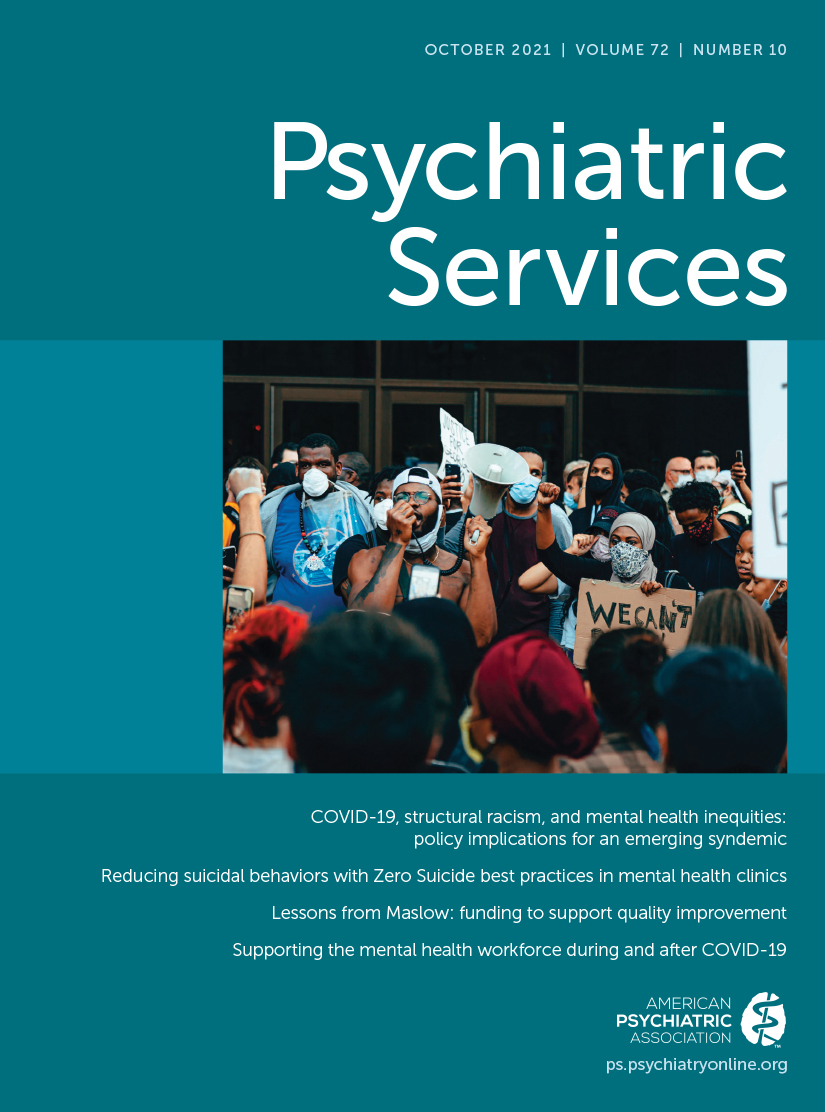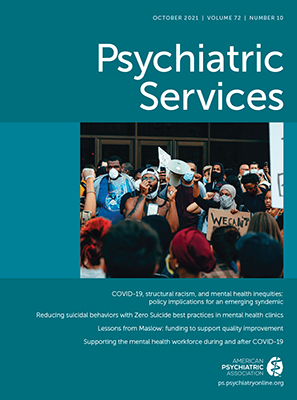Incarceration can pose numerous challenges to experiencing healthy sleep, including separation from family, stress related to legal proceedings, confinement among strangers, disruptions in health care, safety concerns, and other factors (
1,
2). These challenges can reduce sleep quantity and quality, with estimates for the prevalence of insomnia ranging from 11% to 81% in correctional settings (
3). Insomnia is associated with psychiatric symptoms, such as anxiety, hostility, and depression, as well as poor general medical health among incarcerated people (
3,
4). These associations may be bidirectional (
5). Psychiatric and general medical symptoms may cause sleep difficulties; at the same time, research suggests that sleep deprivation might itself contribute to psychotic symptoms, suicidal behaviors, and other adverse outcomes (
5–
7).
In recent years, incarcerated individuals have pursued considerable litigation related to sleep deprivation in U.S. jails and prisons. This column examines litigation over conditions of incarceration that may affect sleep quality and duration as well as policy implications for correctional facilities.
Noise
Because of overcrowding, movement of people, opening and closing of locked gateways, and additional factors, loud noises in correctional facilities can prevent sleep onset and maintenance. In
Harper v. Showers, a man contested the conditions of his confinement in a Mississippi prison after an escape attempt. Among other allegations, he claimed that he was “placed in cells next to psychiatric patients who scream, beat on metal toilets, short out the power, flood the cells, throw feces, and light fires, resulting in his loss of sleep for days at a time” (
8). In 1999, a federal appellate court reversed, in part, dismissal of the complaint, noting that “sleep undoubtedly counts as one of life’s basic needs” and that “conditions designed to prevent sleep, then, might violate the Eighth Amendment” (
8). The case was remanded to district court for further proceedings and later dismissed on other grounds.
By comparison, a man who was placed in a federal prison cell with five other men for approximately 28 months filed a civil rights lawsuit over the constant noise as well as unsanitary environment, poor ventilation, extreme temperatures, and other conditions that he described as “horrifying” (
9). A district court initially dismissed the case, but the U.S. Court of Appeals for the Second Circuit vacated this decision, in part, noting, inter alia, that “sleep is critical to human existence” and that the complaint “plausibly alleged cruel and unusual punishment” (
9). The appellate court remanded the case to district court for further proceedings and, in 2020, a jury awarded $20,000 to the plaintiff. As of October 2020, the case was pending appeal.
Inadequate Bedding
Inadequate bedding in U.S. correctional facilities has been the basis of several lawsuits. In
Lynch v. Sheahan, a man filed a civil rights lawsuit over, among other issues, his transfer to an Illinois jail cell with a mattress on the floor. In 1992, a district court noted that “absent allegations of aggravating circumstances, the Constitution is indifferent as to whether the mattress a detainee sleeps on is on the floor or on a bed” (
10). Because the plaintiff had alleged being required to sleep on the floor among cockroaches and rats, the court stated that these conditions may represent aggravating circumstances that violate constitutional rights. Later, after two remaining defendants argued that he had been transferred to the cell for safety purposes rather than punishment, the court granted summary judgment to the defendants.
On the basis of the 1976 U.S. Supreme Court decision in
Estelle v. Gamble (
11), as well as other cases, deliberate indifference to serious medical needs or risks of harm during incarceration may constitute a cause of action. A case in Connecticut included allegations that a prison-provided mattress had a large slit down its center and smelled of mildew. The plaintiff reported experiencing pain and sleep loss because of the mattress while at least one prison official allegedly disregarded requests for new bedding. A district court held that these allegations constituted a plausible Eighth Amendment violation (
12), and, in 2014, a jury awarded $12,000 in damages to the plaintiff.
Constant Illumination
For security and other reasons, correctional facilities may maintain constant or near-constant indoor illumination, which can affect sleep duration and quality. Incarcerated people wishing to challenge such lighting can face uphill battles in court; still, courts may be willing to consider constitutional claims when there is evidence of sleep deprivation from constant illumination without legitimate penological interests.
In
Keenan v. Hall, a man brought suit against Oregon state prison officials and claimed, inter alia, that “large [fluorescent] lights . . . shone into his cell 24 hours a day,” which prevented him from differentiating day from night, disrupted his sleep, and caused mental health problems (
13). A federal appellate court reversed dismissal of his claims, in part, citing case law that adequate lighting fell under the adequate shelter requirements of the Eighth Amendment and that placing incarcerated people at harm from constant illumination may be unconstitutional (
14). The case was remanded to district court for trial and was later settled.
Constant illumination may be permissible in some correctional contexts. For example, night lights may serve reasonable security purposes in these facilities, because staff must monitor and count incarcerated individuals overnight. In
Vasquez v. Frank, a federal appellate court reviewed allegations by an incarcerated man that included complaints of constant illumination and insomnia in a Wisconsin prison. In 2008, the appellate court affirmed the district court’s decision to grant summary judgment to the prison staff, noting that “24-hour lighting involving a single, 9-watt fluorescent bulb does not objectively constitute an ‘extreme deprivation’ ” (
14).
Medication Restrictions
Given the prevalence of sleep disturbances among incarcerated people, correctional health staff often encounter patients reporting insomnia (
3,
15). Clinicians face numerous challenges, including potential diversion of sedating medications and drug formulary restrictions, when considering prescribing medications for insomnia in correctional facilities (
1,
16). Because of concerns about incarcerated individuals “sleeping away their sentences,” prescribing to treat insomnia may be discouraged or even prohibited in these settings.
Incarcerated individuals also face considerable legal hurdles when suing for access to sleep-related medications. Several court decisions have cast doubt on whether insomnia alone constitutes a “serious medical need” (
17). Nonpharmacologic treatment or the availablility of alternative medication options may also provide sufficient evidence for courts to dismiss these types of claims (
17).
Early Wake-Up Times
Because of the unique demands of correctional environments, incarcerated people may be subjected to irregular schedules that disrupt sleep. For instance, when defendants must appear in court, correctional staff might have to wake them early for meals, medications, showering, security measures, and transportation. If these early wake-up times are unreasonable or do not serve legitimate purposes, incarcerated individuals may have grounds for relief, as indicated by a recent case in California. Incarcerated individuals filed a class action complaint over sleep deprivation, given a jail’s policy to keep lights on until at least 11:00 p.m., administer medications at 2:30 a.m., and turn lights back on at 4:00 a.m. for breakfast. As summarized by a judge in district court, “Defendants give detainees no more than five hours of lights-out time, and on occasion even less if cell cleaning isn’t finished” (
18).
In 2019, the judge granted, in part, a preliminary injunction against these practices, writing, “No one can argue with the proposition that detainees with medical needs should get their prescriptions, but why at 2:30am?” (
18). Defendants on behalf of the jail had argued that early wake-up times were necessary for transportation to morning court proceedings, but the judge cast doubt on these arguments, writing that “defendants do not proffer any facts showing that turning the main lights on and serving breakfast throughout the jail at 4:00am is itself justified” (
18).
Policy Implications
This column examines just a sample of legal cases regarding sleep deprivation in U.S. jails and prisons. Given the scale of mass incarceration in the United States, including its disproportionate effects on minority and indigent populations, further research is needed to better understand and address the health effects of sleep deprivation in U.S. correctional facilities. The potential adverse effects of inadequate sleep on incarcerated individuals, as well as associated litigation, suggest the need for policies that reduce unnecessary sleep deprivation and promote healthy sleep in correctional contexts.
Achieving these goals is not necessarily simple. For instance, correctional staff may face competing legal requirements that affect incarcerated individuals’ sleep. In one example, a man filed suit over sleep deprivation from noisy, around-the-clock welfare checks in a California prison (
19); however, a federal appellate court held in 2020 that the prison officials were entitled to qualified immunity, because a court order from separate litigation had required staff to conduct these checks for suicide prevention. This conflict demonstrates how correctional staff can risk litigation from both action (e.g., waking up incarcerated people with welfare checks) and inaction (e.g., failing to prevent suicides by not conducting welfare checks) during night hours.
Addressing structural risk factors, including lighting, bedding, overcrowding, and noise, is essential for mitigating sleep deprivation during incarceration. Ignoring these factors may foster many downstream effects, including increased psychiatric symptoms, suicidal behaviors, demand for mental health services, medication prescribing and diversion, and litigation (
1,
3–
7). When structural risk factors are unavoidable because of security and operational constraints, custody and health staff can collaborate to develop and implement evidence-based policies to mitigate these downstream effects. For example, providing incarcerated people with ear plugs or eye masks may be one strategy to decrease sleep disruptions. Whenever possible, facilitating participation in outdoor or out-of-cell activities, including exercise, may help regulate sleep-wake cycles. Developing systems for overnight population counts or suicide prevention that minimize noise and light disruptions is another approach.
From a clinical standpoint, health professionals may feel conflicted when caring for incarcerated patients with sleep difficulties. Some have noted that “the expectation of eight restful and uninterrupted hours of sleep may not be realistic” in correctional environments (
1). Many standard practices for insomnia management, such as providing access to continuous positive airway pressure machines or prescribing benzodiazepine receptor agonists, may not be feasible in all correctional facilities (
1). These barriers have led at least one physician to ask, “In correctional health care, should we even treat insomnia?” (
15)
Given the suffering, health risks, and other consequences associated with sleep deprivation, clinicians have a responsibility to evaluate and treat incarcerated patients with sleep-related concerns, including underlying conditions that may be contributory. Institutional treatment pathways can support decision making in these scenarios (
20). Some evidence suggests that nonpharmacologic strategies, such as relaxation techniques or brief cognitive-behavioral therapy, may help mitigate the effects of incarceration on sleep, and turning to these strategies before pharmacotherapy may be useful for treating insomnia in correctional settings (
1,
3,
20). Careful review of insomnia-related medication prescribing patterns, analysis of patient outcomes, and use of evidence-based formulary restrictions are also key for supporting patient well-being (
16).
U.S. courts have communicated that incarceration does not need to be comfortable (
8,
12); still, litigation continues to highlight the ways in which sleep deprivation may be harmful—and excessive—in U.S. jails and prisons.

